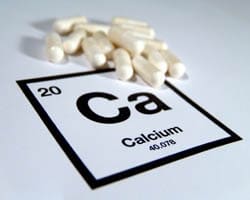
There are a variety of calcium supplements on the market. The wide variety begs the question: Are all calcium supplements the same?
The answer is a resounding NO!
Calcium Compounds
Calcium measured in milligrams (mg) is found in compound form, which means it is bound to a molecule, such as:
- Carbonate
- Citrate
- Gluconate
- Phosphate
- Lactate
Elemental Calcium
There is very little regulation when it comes to the manufacturing of supplements. That being said, some calcium supplements contain more calcium per pill than other products. You might think you are getting a good deal, but then you come to discover that there is very little elemental calcium and more inert ingredients than you expected.
For example, calcium carbonate contains the highest percentage of elemental calcium at 40%. Because of this fact, it is most widely prescribed for those individuals requiring a higher daily dietary intake.
Calcium citrate comes in second with 20%. Calcium lactate is 13%, and calcium gluconate is 9%.
The best way to determine elemental calcium is to read the nutritional label and search for the amount of absorbable calcium found in each tablet.
Absorbable Calcium
Another important factor to take into consideration is the fact that not all calcium is absorbed in the same manner. For example, it is recommended that calcium carbonate be taken with a meal, while calcium citrate should be taken on an empty stomach.
Moreover, some calcium supplements contain other active ingredients that you may not need, such as calcium phosphate, which contains not only calcium but phosphorus as well. Too much phosphorus can pose a problem for individuals with chronic renal disease as the kidneys have trouble clearing phosphorus. As well, there are factors that can drain calcium from your body.
The Chewable Antacid Debate
The primary purpose of chewable antacid tablets is to help reduce excess stomach acid, which sometimes occurs during the digestive process. Tums, for example, has 200 mg of elemental calcium, which is why it was often prescribed by doctors as a low cost means of obtaining more calcium.
However today, there is a big debate over the use of Tums as a calcium source. Some suggest it can interfere with proper stomach acid production. Regardless, Tums should not be relied upon as a calcium source. Instead, choose foods rich in calcium such as almonds, yogurt and other milk products, broccoli and collard greens.
Recommended Daily Allowance (RDA)
The RDA is a general guideline that is used to calculate individual daily needs or personal RDA.
Sometimes the RDA varies depending on the source utilized. For example, during an Internet search one site stated that the RDA for adults (18+) ranges from 800–1500 mg, while another site stated the RDA for adults is 1000–1300 mg.
Let us say for argument sake that the manufacturer of your bottle of calcium supplements uses an RDA of 1000 mg. Moreover, the nutritional label reads that one tablet of calcium provides 50% of the RDA. So in this case, one tablet would provide the general population with 500 mg—or half of their daily allowance.
Let us take this one step further. Suppose an individual has a personal RDA that is higher than the general population, at 1500 mg per day. Based on the above calculations, that same tablet would provide this individual with only one-third of their daily required intake (1500 mg divided by 500 mg), increasing the daily requirement to three tablets per day.
RDAs are general guidelines that fail to take into consideration a number of important variables such as:
- Dietary needs
- Medication interactions
- Chronic health care problems
In conclusion, individuals with chronic health care problems or dietary issues or who are taking certain medications should not take calcium supplements without first discussing those issues with a health care provider.
In addition, although the RDA generally recommends 1000 mg of calcium per day, that requirement can vary depending on certain conditions like pregnancy, breastfeeding, menopause and other stages of life.










